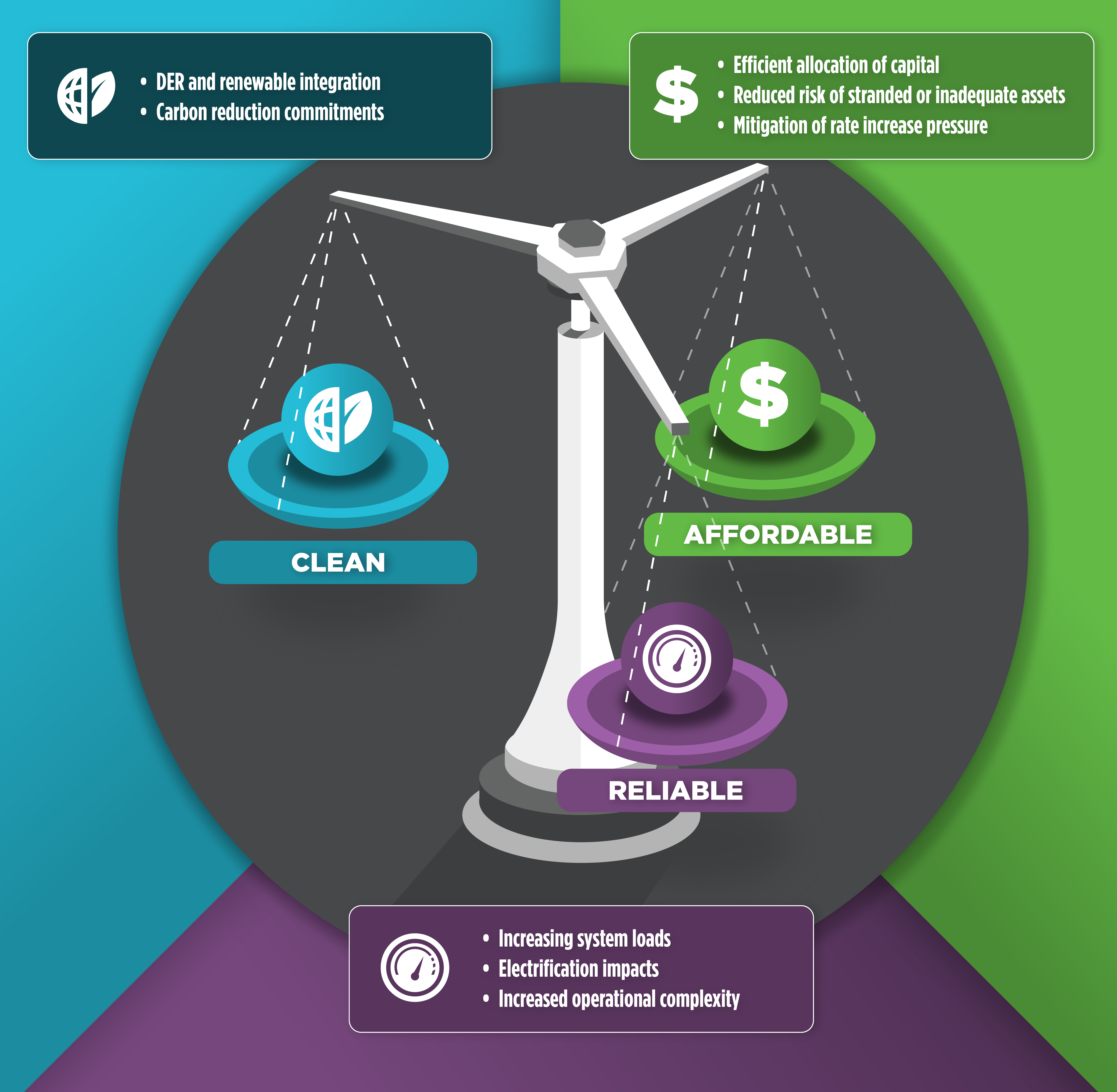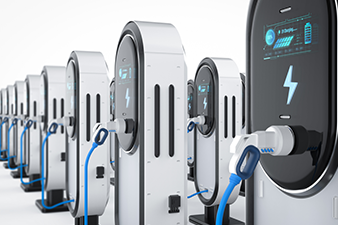
Originally published in Energy Central. Carlo Brancuccu, Ph.D. and Wallace Kenyon, Ph.D., of encoord, are co-authors.
The electric industry today is facing unique and unprecedented challenges. A changing generation mix, more frequent “100-year” storms, and tremendous load growth are all changing the way utilities need to plan the electric system. As the generation mix changes, resources with very different operating characteristics than traditional base load plants are dominating interconnection queues (primarily renewables and battery storage). Load growth due to the development of data centers, the onshoring of manufacturing, and electrification of heating and transportation are putting the electric sector in the center of important conversations about economic growth and development. These challenges require an “all-hands-on-deck” approach to reliability; however, planning organizations and processes are generally not set up to meet this challenge.
This article is the second in our three-part series on integrated system planning (ISP) and is focused on the benefits of ISP for helping utilities address these reliability challenges while also balancing the need to provide affordable and clean energy to customers. The first article in the series focused on how ISP supports utility affordability objectives.

The industry has, for several decades now, tended to view generation planning as a separate activity from planning the wires side of the business. As an example, the integrated resource planning process in many states may not address transmission needs at all. In regions with deregulated wholesale markets, generation development is driven by the market while transmission is planned by the independent system operator.
Transmission and distribution planning are often managed separately due to different organizations or regulatory treatment. Depending on the utility, these functions often do not use the same planning tools or even the same load forecasts.
These two interfaces, between generation and transmission and transmission and distribution, if managed in a more coordinated manner, hold tremendous promise for planning the electric sector more effectively. This will be necessary if utilities are to meet myriad challenges of providing reliable, resilient power to existing customers and to a growing base of industrial users.
Generation and Transmission
Capacity expansion modeling, resource adequacy analysis, and production cost modeling have traditionally driven generation resource decisions, focusing primarily on the relative costs, availability, and operational characteristics of these assets. In many cases, the traditional approach assumed that transmission was both available and not a primary driver of costs. Given the difficulties in building transmission today and the growing spatial and temporal variability of generation and storage assets, this assumption no longer holds true.
As more renewables are deployed, the generation mix is becoming more dependent on weather, and for this reason, the locations of these renewable resources matter. As such, the transmission to interconnect these resources is now critical and an important part of the assessment of reliability of the resource mix. FERC recognized this in its recent order on regional planning—Order 1920.
Given the need to interconnect an increasing variety of types of generation and storage with more and more miles of transmission, the ability to identify and propose the optimal mix of resources, informed by the availability of transmission (or its need), becomes paramount. To the extent that generation and transmission planning tools (e.g., production cost modeling and load flow analysis) can be utilized in concert, the utility or generation planner has a much better view of the generation and transmission resources required to meet reliability and resilience needs.
Traditional Generation and Transmission Planning vs. ISP
Under traditional utility planning practices, generation planning’s goal is to plan the least-cost resource mix adequate to meet future needs, including demand growth and policy or corporate goals. Transmission planning is then responsible for planning a reliable and stable transmission network that ensures power can flow from the identified generation sources to demands at all times.
Through ISP, generation and transmission planners can coordinate and improve their planning processes by leveraging an integrated planning processes and tools that allow them to iterate between their modeling studies. Generation can coordinate with transmission by sharing the hourly commitment and dispatch conditions for different future scenarios for which transmission can run power flow studies. Transmission planning can condition the power flow cases and run contingency analyses to share system reliability constraints and/or transmission investment needs with generation so generation can evaluate potential solutions, such as re-dispatching or investments in different assets. Generation and transmission can optimize an adequate resource mix and reliable transmission network by integrating their planning processes. The result of this enhanced coordination is a resource plan that better incorporates transmission constraints and costs and represents the true least-cost set of investment to meet system needs, while also better accounting for reliability considerations.
Transmission and Distribution
Transmission and distribution planners have traditionally used separate tools to assess different types of challenges on their networks. In transmission, power flow analysis generally identifies thermal and other constraints and highlights areas of the grid in need of upgrade based on NERC standards. Distribution planners have often focused on the worst-performing circuits and upgrades to enhance key reliability metrics (SAIDI, SAIFI, and CAIDI). Both transmission and distribution organizations typically have had programs focused on reactive and preventive maintenance, as well as the replacement of aging infrastructure and connecting new customers.
As a variety of assets come into use on the transmission and distribution system, the need to assess transmission and distribution solutions holistically is becoming more and more important. For instance, battery storage can provide reliability and economic benefits to both transmission and distribution systems. Which organization is responsible for assessing these? How are benefits on “the other side of the substation” considered?
As distributed energy resources (DERs) become more prevalent and have the ability to impact performance of the transmission system (e.g., 3-5 MW solar installations connected at sub-transmission), the tools and processes needed to study these impacts may be lacking. The same is true for aggregated DERs that may either alleviate or exacerbate transmission congestion under certain conditions. Given FERC Order 2222, the industry will see more of these situations in the years to come.
As new and large loads continue to request interconnection to transmission and distribution networks, the ability to holistically assess the impacts to the grid is critical. This assessment is also driving the discussions with regulators about the allocation of costs to serve these loads. Planning that does not consider both transmission and distribution (and likely generation) impacts will prove inadequate to effectively and reliably integrate these new customers.
Evaluating the transmission and distribution systems separately has been generally sufficient to date; however, it likely will not be in the years to come as new resources and customers reshape the grid. As such, taking steps to model these systems and contingencies together to find the most appropriate, reliable solution is becoming more and more important.
Traditional Transmission and Distribution Planning vs. ISP
Under traditional planning practices, the job of a distribution planner is to ensure the reliable delivery of electricity to customers and define infrastructure upgrades to address the growing demand and integration of DERs. Transmission planners run power flow studies of the transmission network by representing distribution feeders as single-point demands. However, these demands often do not reflect the diversity and complexity of the local distribution networks and any DERs connected to them.
Similar to the generation and transmission example above, through ISP, transmission and distribution planners can coordinate and improve their planning processes by leveraging an integrated planning process and tools that allow them to iterate between, and combine, their modeling studies. Transmission planning can coordinate with distribution planning by sharing thermal and voltage constraints at the substation interconnection points. Transmission planning can share these constraints as time series to reflect the variability in the state of the system across the 8,760 hours in a year. Distribution planning can use these constraints to inform unbalanced power flow studies of the distribution network in a scenario-based approach. In a collaborative approach, distribution planning can then share loading deviations and potential credible conditions with transmission planning so they can enhance the representation of demand, DERs, and distribution network constraints in the transmission model. Transmission planning and distribution planning can also run combined simulations by running unbalanced power flow simulations of the combined transmission and distribution system. This allows them to capture interdependencies between the two parts of the network and evaluate how distribution network assets may impact the state of the transmission network and vice versa. Again, similar to the generation and transmission ISP coordination described above, all of this enhanced coordination results in better identification of least cost investments required to manage increased system complexity and reliability considerations across the transmission and distribution networks.
Conclusion
Changes across the electric value chain necessitate optimizing investments across generation, transmission, and distribution assets. Generation, transmission, and distribution planning can coordinate their processes by leveraging a common data structure, planning assumptions, and a single integrated modeling platform. The benefit of this enhanced coordination is a more optimal capital investment strategy that delivers lower cost solutions while accounting for increasingly complex operational and reliability considerations.
An important next step for organizations interested in pursuing ISP is selecting the interface (generation and transmission or transmission and distribution) to start their ISP journeys and then identifying the most valuable use case(s) to test. This process can surface reliable and lower-cost alternatives that may not have otherwise been identified, while also building ISP capabilities that can be used to further expand the implementation of ISP within the organization. Ideally, proving out select use cases can make the case for broader integration of electric planning functions.






